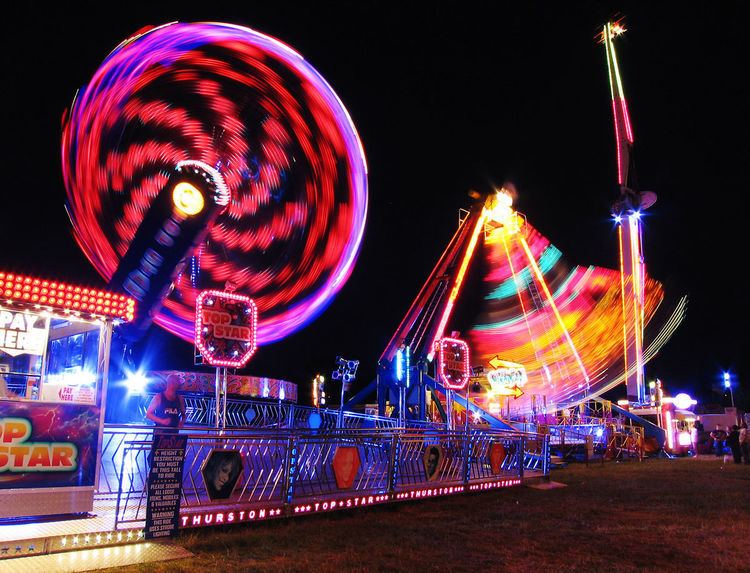 | ||
A travelling funfair, often simply called a fair, is a small to medium-sized travelling show primarily composed of stalls and other amusements.
Contents
The British term "funfair" is also used to refer to non-travelling amusement parks. Larger fairs such as the permanent fairs of cities and seaside resorts might be called a fairground, although technically this refers to the land where a fair is traditionally held.
Attractions
Fairs contain a mixture of attractions which can be divided into the categories of adult, teenager and child; usually including thrill rides, children's rides, sideshows, and side stalls. Originally, a fair would also have had a significant number of market stalls, but today this is rare and most sidestalls only offer food or games. The first fairground rides began to appear in the eighteenth century, these were small and made of wood and propelled by gangs of boys. In 1868, Frederick Savage, an agricultural engineer from King's Lynn, devised a method of driving rides by steam. His invention, a steam engine mounted in the center of the ride, transformed the fairground industry.
Thrill rides
There is constant innovation, with new variations on ways to spin and throw passengers around, in an effort to attract customers. With the requirement that rides be packed into one or more trailers for travel, there is a limit to the size of the rides, and funfairs struggle to compete with much larger attractions, such as roller coasters, found in amusement parks. See also amusement rides.
Roller coasters
Some fairs may feature compact roller coasters to attract teenagers and preteens. Roller coasters feature steep drops, sharp curves, and sometimes loops. Roller coasters are generally the most attractive aspect of a fair, but many people come for other reasons. Fairs usually only feature one or two coasters.
Children's rides
Funfairs are seen as family entertainment, and most include a significant number of children's rides. Many of these are smaller, platform based rides like, cup & saucer, toy sets, train rides then there are smaller slower versions of the adult rides, Ferris wheels, waltzers, even children's bumper cars. Such rides are usually referred to as "juvenile rides" or just juveniles. There are other items for children, slides, mirror mazes fun houses, and variations on the bouncy castle.
Sideshows
In the 19th century, before the development of mechanical attractions, sideshows were the mainstay of most funfairs. Typical shows included menageries of wild animals, freak shows, wax works, boxing/wrestling challenges, and theatrical shows.
Side stalls and games
Most stalls feature games of skill or strength. The most traditional example being the coconut shy in which players throw balls at coconuts balanced on posts, winning the coconut if they manage to dislodge it.
Other side stalls range from the trivially easy, such as hooking rubber ducks from a water trough in which nearly every player is expected to win a prize, to the deceptively challenging, which includes games which utilize optical illusions or physical relationships that are difficult to judge. Highly profitable (and therefore timeless) games include:
Much of the true "con artistry" has been driven out of funfairs in the twentieth century, and combined with an increasing emphasis on the role of families and small children in such entertainment, contemporary showmen often find greater profit in pricing their games far above the value of the prizes being offered, with complex formula for upgrading to the large prizes that advertise the game and instill desire among customers. The rises in pricing of many side stalls must often reflect the overheads of running fairground equipment – the cost of swag (see below), diesel, staff, and rents.
Typical prizes change to reflect popular tastes. A traditional fairground prize used to be a goldfish in a small plastic bag, but these have fallen out of favor, partly because goldfish are no longer seen as exotic, but also because of animal welfare concerns. Many stalls offer cuddly toys as prizes – many teenage romances are established at funfairs, where thrill rides provide ample excuse for embracing. Displays of skill at shooting and winning a cuddly toy for your girlfriend is a rite of passage for many young men. In show land, the prizes are known as swag and are supplied by a swag man.
